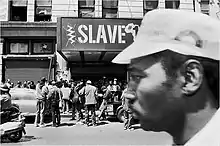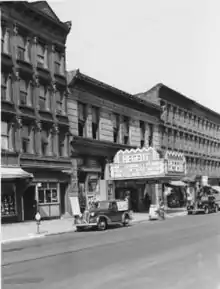Slave Theater
Slave Theater, also called the Slave I, was a movie theater located at 1215 Fulton Street in Bedford–Stuyvesant, Brooklyn, New York City. The theater was founded in 1984 by Brooklyn judge John Phillips to screen a film he had produced and became a center of civil rights organizing in Brooklyn. It was named as a reminder of slavery as the origin of African-American and black American history. The name had a mixed reception by the Bed–Stuy community, but the theater became known as an emblem of Black pride in Brooklyn. After a complicated legal battle over ownership after Phillips's death, the theater was sold in 2013 and demolished in late 2016.
Slave I | |
 Street view of the Slave Theater marquee, before the theater was demolished in 2013 | |

| |
| Former names | Regent Theater |
|---|---|
| Address | 1215 Fulton Street |
| Location | Brooklyn, New York 11216 |
| Coordinates | 40.680677°N 73.952772°W |
| Type | Movie theater |
| Construction | |
| Built | 1910 |
| Opened | 1986 |
| Closed | 2012 |
| Demolished | 2016 |
History

In 1984, Brooklyn civil court judge John Phillips[1] bought and renamed the Regent Theater (built in 1910[2]). He had produced an interracial romance film Hands Across Two Continents and couldn't convince theaters to screen it, so he bought two theaters in Brooklyn to have the movie played.[3] He renamed the Regent Theater the Slave Theater because, according to the website Brownstoner, he wanted to "remind everyone in the community, including himself, where they came from. He didn’t particularly care that many in that community were offended by the name, either".[1] In response to a series of violent hate crimes in Queens later in the 1980s, Judge Phillips opened the theater as a space for the local Black community and civil rights work; Al Sharpton started holding weekly rallies at the theater,[4] which he cites as a reason for increased civil rights organizing in Brooklyn at the time.[5] For example, the Slave Theater was a gathering point for marches (and speeches by Al Sharpton and C. Vernon Mason) following the acquittal of John Vento and Keith Mondello for the murder of Yusef Hawkins in August of 1989.[6][7]
Judge Phillips was declared mentally unfit due to dementia in 2001 and died in 2008 due to neglect in a Brooklyn nursing home.[8] For years, a series of guardians and estate lawyers had stolen most of Phillips's investments. Because he died without a will, the Slave Theater was left without funds to support itself and in unclear legal status.[9] In the confusion, the theater fell into disrepair and was ordered vacated by the city of New York in 2012 after its patio collapsed during a party, injuring four people.[10][11] A local group, the New Brooklyn Theatre began a Kickstarter fundraising campaign to try and buy the theater when it was put up for auction in 2012. The Slave Theater's manager and friend of Judge Phillips, Clarence Hardy, and his son Omar also claimed ownership of the property at the time. Clarence had been living in the building for years, at the behest of Judge Phillips.[5] The Hardy family claimed that Judge Phillips had granted them ownership of the theater in 1999.[10]

A New York Surrogate's Court judge ruled that Judge Phillips had transferred the property to the Hardys when he was of unsound mind, and therefore granted ownership of 1215 Fulton Street to Phillips's nephew and executor Rev. Samuel L. Boykin of Akron, Ohio.[12] Boykin characterized the Hardys, and a church that had been renting the upper floors of the theater, as squatters[13] and planned to have them evicted from the site in 2012.[14] Then, Boykin sold the theater to the Fulton Halsey Development Group in August 2013 for $2.1 million,[15] before an appeal by the Hardys was completed.[16][12] In his continued attempts to save the theater, Clarence Hardy protested the proposed demolition of the theater by standing on top of its roof and threatening to jump unless the theater was saved.[17] Other anti-gentrification activists also opposed the theater's destruction by organizing community protests.[18][19] Nonetheless, in December of 2016, the lot's new owner Industrie Capital Partners demolished Slave Theater with plans to create a mixed-use development.[20]
In 2019, a London firm called The Collective bought 1215 Fulton Street and several surrounding lots for $32.5 million dollars.[21] The Collective stated that they are developing a plan for memorializing the history of the Slave Theater in the resulting mixed-use development.
Architecture
Exterior
The main exterior alteration made by Judge Phillips was the installation of the Slave Theater's iconic black-and-white marquee.
Interior
Judge Phillips had community artists paint murals all over the interior walls of the theater of heroes from Black history, like Toussaint Louverture, Marcus Garvey, and Malcolm X, as well as one of Bruce Lee.[1]
References
- Judge Phillips was known as the "Kung-fu Judge" for his high-level black belt and his founding of the "Gorilla-Gnat System of Scientific Movements and Defensive Fighting", which he taught in a dojo in Brooklyn. Spellen, Suzanne (14 December 2015). "Slave Theater – Brooklyn's Former Hub for Black Pride and Social Justice". Brownstoner. Retrieved 27 July 2019.
- Freudenheim, Ellen (2016). The Brooklyn experience : the ultimate guide to neighborhoods & noshes, culture & the cutting edge. Rutgers University Press. p. 66. ISBN 978-0813577432. Several sources refer to the 1215 Fulton theater prior to 1986 as the "Regal Theater", but the majority of sources do not.
- The other theater is now called the Black Lady Theatre, colloquially referred to as the Slave II. Smith, Rachel. "Restoration of Black Lady Theatre Underway in Crown Heights". DNAinfo New York. Retrieved 27 July 2019.
- For a short description of a journalist's visit to one of these rallies, see Newkirk, Pamela (September 2002). Within the veil : black journalists, white media. New York: New York University Press. pp. 154–155. ISBN 978-0814758007.
- Leland, John (10 February 2012). "The Slave Theater in Brooklyn at Center of Bitter Battle Over Ownership". The New York Times. New York Times. Retrieved 27 July 2019.
- Hevesi, Dennis (3 September 1989). "No Violence as 300 March Into Bensonhurst Again". The New York Times. Retrieved 27 July 2019.
- McFadden, Robert D. (10 September 1989). "300 Demonstrators Are Met With Silence in Bensonhurst". The New York Times. Retrieved 27 July 2019.
- Saul, Josh; Narizhnaya, Khristina (16 February 2015). "Family of judge who froze to death to get $750K from nursing home". New York Post. Retrieved 27 July 2019.
- Saul, Emily (7 April 2016). "Lawyer probed in 'Kung Fu Judge' missing $700K inheritance". New York Post. Retrieved 27 July 2019.
- Disser, Nicole. "The Continuing Saga Of The Slave Theater Gets Curiouser and Curiouser". Brooklyn Magazine. Retrieved 27 July 2019.
- Durkin, Erin. "Judge slaps vacate order on historic Slave Theater on Fulton St. in Bed-Stuy after injuries at party". nydailynews.com. Retrieved 27 July 2019.
- Chaban, Matt A. V. (28 December 2015). "As Demolition Looms, Slave Theater's Ownership Is Disputed". The New York Times. Retrieved 27 July 2019.
- Due to the legal status of the Hardy's appeal for ownership, it's unclear if Hardy living in the property actually constituted squatting.
- O’Neill, Natalie. "Church to upstage famed civil rights theater". Brooklyn Paper. Retrieved 27 July 2019.
- Maurer, Mark (16 August 2013). "Fulton Halsey buys Slave Theater in Bed-Stuy for $2.1M". The Real Deal New York. Retrieved 27 July 2019.
- Villareal, Alexandra (22 May 2015). "A New Theater Company Looks for a Home in Bed-Stuy's Slave Theater". Observer. Retrieved 27 July 2019.
- Eldredge, Barbara (7 December 2015). "Slave Theater Brooklyn: Man Protests Demo By Threatening to Jump". Brownstoner. Retrieved 27 July 2019.
- Viagas, Robert (2015). "Fans Organize to Save Brooklyn's 'Slave Theatre'". Playbill. Retrieved 27 July 2019.
- MacMillan, Thomas. "Activists Battle to Save Brooklyn's Historic 'Slave Theater'". WSJ. Retrieved 27 July 2019.
- Devlin, Seán (21 March 2017). "Slave Theater Demolished as Bed Stuy Icon Makes Way for Mixed-Use Development". Brownstoner. Brownstoner. Retrieved 27 July 2019.
- Hubert, Craig. "London Co-Living Firm Buys Slave Theater for $32.5 Million, Plans 'Cultural Programming'". Brownstoner. Retrieved 27 July 2019.
- Go-Rilla Means War installation
- accompanying catalog
- Massara, Kathleen (23 February 2018). "The Slave Theater Lives On Through Crystal Z. Campbell". Guernica. Retrieved 27 July 2019.
- Rooney, Kara L. (8 July 2010). "The Slave Theater". The Brooklyn Rail. Retrieved 27 July 2019.
- Slave One
Further reading
- Ketcham, Christopher (7 March 2008). "The Slave Auctions and the End of the Kung-Fu Judge". The Brooklyn Rail. Retrieved 27 July 2019.
- Lee, Trymaine (18 November 2007). "A Symbol of Activism Is at Center of Court Dispute". The New York Times. Retrieved 27 July 2019.